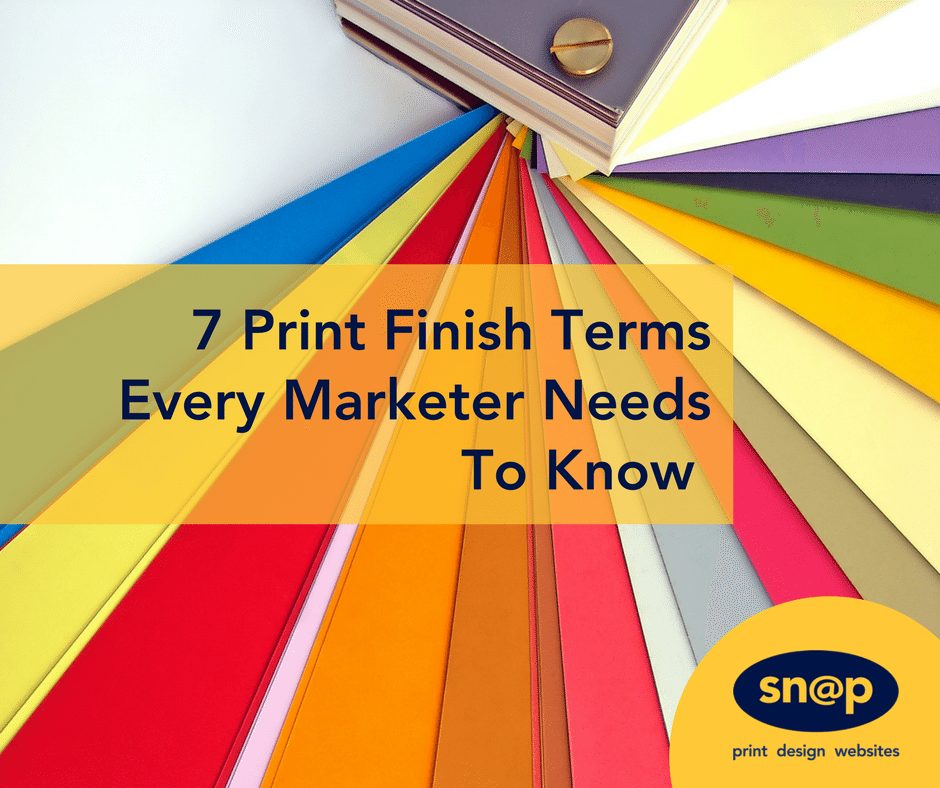Your Snappy Guide to Print Finishes Starts Here
Get the best look, feel and results from your print jobs.
Understand what different print finishes mean, and how they can be used, and what’s involved in print finishing.
A Snapshot of Print History
Ever since Johannes Gutenberg released the first Printing Press 1.0. technology has changed our ability to reproduce images. now you can print on almost any surface, create a variety of effects and even go 3D. Today, businesses use a wider assortment of printing techniques and finishes to stand out and impress prospects and clients.
Today, businesses use a wider assortment of printing techniques and finishes to stand out and impress prospects and clients.
Let’s Demystify All That Print Jargon.
Today, you have an amazing assortment of printing techniques and finishes to help your marketing and messaging stand out, get personal and impress prospects.
By the end of this blog, printer-geek lingo such a die-cutting, triplexing and foil blocking, will be a no-brainer to you
1. Die Cutting
The most conventional method of shape-cutting. This is where we cut sheets of paper or printable material using a flatbed tool. We cut it to any shape and size you desire.
When To Use Die Cutting
A great option when:
- You’ll need a big run of a unique, non-conventional shape.
- Your designs won’t change soon.
- You are likely to have repeat orders
- You don’t need minute detailing.
Die Cutting is ideal for:
- postcards
- tags
- labels
2. Laser Cutting
The hint is in the title.
Laser cutting is where a highly focused beam cuts the printable material. It’s highly flexible because it can cut unlimited and often very intricate shapes with no tooling. (a cheaper and faster method).
Changes can be made easily and the only limit to your chosen shape is your imagination.
When to use Laser Cutting:
- You are using intricate designs
- Your designs change frequently.
Laser Cutting is the ideal choice for:
- POS material
- Signage
- Invites and premium Greeting Cards
- Confetti
- Popup cards
3. Duplexing and Triplexing
Duplexing happens when we paste two sheets of paper together to make one thicker sheet. As you can guess triplexing involves pasting three sheets together. It’s a great way to increase the impact, tactility perceived quality of your print job.
Why Duplexing and Triplexing will enhance your marketing.
It allows you to
- Increase the impact and authority of your collateral,
- Enhance the perceived quality of your print job.
- Improve durability
Duplexing and Triplexing is an ideal choice for:
- Business Cards
- Postcards
- Swing Tags
- Direct Mail
4. Foil Blocking
This is where a moulded metal die is stamped onto paper with an ultra-thin sheet of metal foil in between. This transfers the metal foil to the paper in the shape of the customised die. The result is a stunning visual effect. It’s particularly effective if combined with embossing or debossing.
The result is a stunning visual effect. It’s particularly effective if combined with embossing or debossing.
It’s quite labour intensive. So naturally a more expensive value-driven option suitable for:
When to use Foil Blocking in your marketing material.
It is suitable for:
- Invites
- Logos
- Direct Mail
5. Printing Opaque White
Modern advances in printing allow us to deliver the same sort of rich, dense whites on dark-coloured stock that screen-printing also offers.
Using white transparent ink on colours can produce stunning results in:
- Posters
- Banners
- Books
- Brochures
6. Varnishing And UV Varnish
We spray varnish onto a surface for a shiny, glossy look. It also offers protection to the printing underneath. If
Why use Varnishing in printed material?
It also offers protection to the printing underneath. If your print job is likely to be outdoors and will be exposed to the elements, UV varnish.
If your print job is likely to be outdoors and will be exposed to the elements, UV varnish is an ideal solution.
Any relevant printing and colour work must be completed before we begin varnishing the item.
Varnishing is an ideal print finish for:
- Brochures and Flyers
- Packaging
- Indoor and Outdoor Posters
- Signs and Banners
7. Embossing And Debossing
This refers to the technique where the print stock is raised or sunken to achieve a 3D effect. It is done using a metal plate. Pressure pushes the paper into the plate to create the embossed or depressed effect.
Why use Embossing and Debossing in your print collateral?
Great for creating:
- A classy, premium visual effect
- A unique eye-catching feature
- A discreet subtle differentiator to your print projects.
When to use Embossing or Debossing:
It is an ideal print finish for:
- Hardback and special edition Book Covers
- Business Cards
- Certificates and Awards
- Invitations especially the VIP ones
Get friendly, tailored and expert advice.
#TalktoSnap
Whatever your understanding of the popular printing techniques and finishes, we’ll still make a point of getting to know your business. and tailoring these options to your specific our promotions and marketing.
There’s nothing like a one-to-one chat with a friendly face for tailoring these options to your specific our promotions and marketing.
Sure, there’s a lot more to printing than these. techniques. We’ll talk you through stocks, size options, the ideal use of colours in your branding, design, and even help you with distribution and more.

